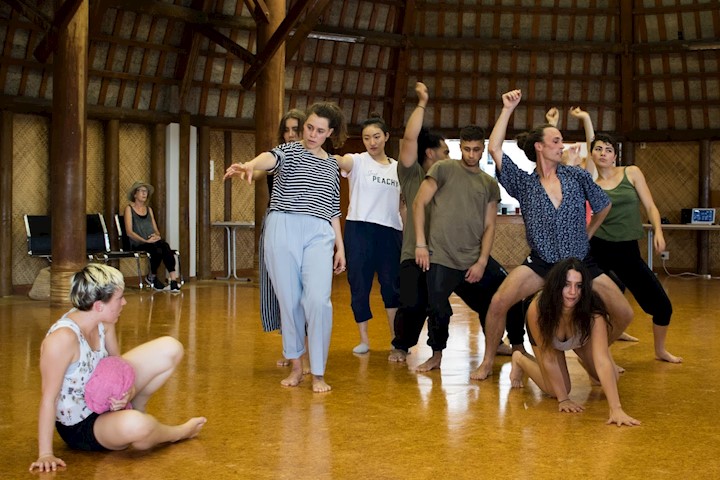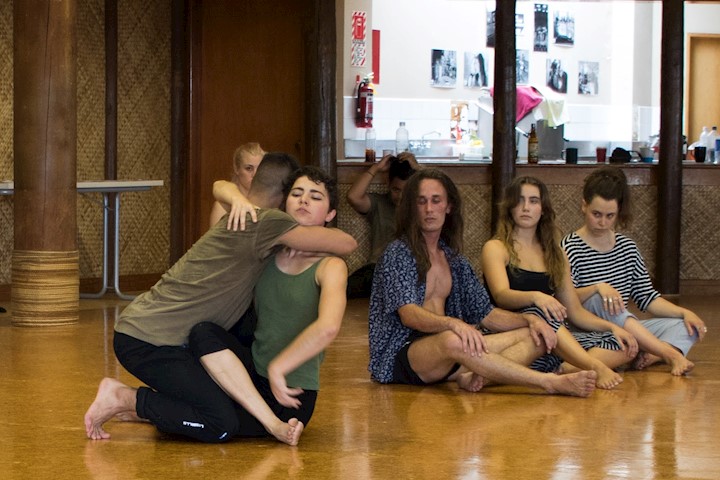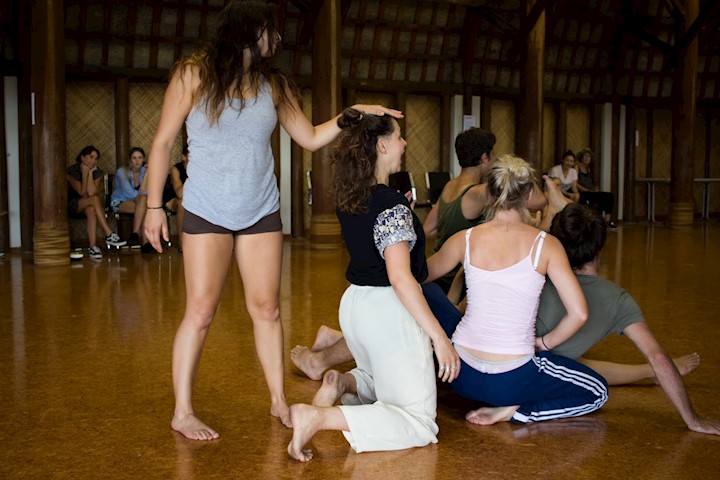Composure is an improvised dance practice which challenges common modes of choreography and performance. At the core of this project is a desire, as dance artists, to find a sustainable practice; to investigate our dance-making interests; and to continue to discover choreographic methods. The focus is on how we each approach the task of making; what we are interested in seeing bodies do; and how we get them to do it. We use movement, dance and voice to interact with sound, space, and people; performers shift within the space generating an experience that is both created and explored in its moment of inception. A creative practice that initiated as a student choreographic project in 2015, Composure has developed as a weekly practice, a cumulative process with a practice-as-research approach to making choreography, driven by our personal and collective modes of live decision-making. A discussion at the end of each session is where the value in our learning lies; we seek to understand our natural patterns and how harnessing these to then foster or oppose them can broaden and deepen our skill in live-choreography. We created a blog to record our practice, reflections, and to share these with a wider circle of dance-makers.

We deconstructed the roles of choreographer and dancer to create new terminology:
- Dancer is Shifter: they make, move, offer ideas, drive the piece; taking away the term ‘dancer’ also allows shifters to broaden the spectrum of material they create.
- Choreographer is Shaper: they mould, meld, give structure to the piece.
During each improvisation, a shaper stands at the edge of the space and provides direction to the group.
On Saturday 25 February 2017, as part of the Auckland Fringe Festival, we shared Composure as a 12-hour improvisational piece; we began at 11 am and danced through to 11 pm. The purpose: to open our dance practice for others to observe, participate in, and contribute to the simultaneous making and performing of Composure. The outcome: a wild 12 hours of improvising and making dance, exploring ideas and letting ideas go, pushing through physical exhaustion and our creative capacities, shifting past traditional boundaries of a theatrical performance and expectations around the roles of performer and audience.
We began on our own, no one watching, which gave us time to settle after a warm up, to Compose the Space and establish our connections with the space and with each other in the space. From here the task melted in to a movement improvisation, eight shifters moving and speaking.
The first group of people arrived, we greeted them. We softened the set up by chatting, welcoming, giving a written list of possibilities for how they may view or participate in the work and offering them a seat on the outside of the room. This seating, along two architectural channels, formed a non-frontal performance space with undefinable edges as the ‘audience’ walked through to their seats and the performers entered or left the space at ease and with free choice. This dissolving of the physical borders between audience and performer enabled the dissolving of expectations of traditional performance: how each participant behaves and what they expect from the other. In doing this, we sought to offer an opportunity to see how dance is made; how it evolves and develops. People could observe our methods of making dance (our processes, explorations, triumphs and failings) and to also engage in the creation of the piece.

Audience people were invited to come and go throughout the day and many came for an hour or so, left to eat lunch, then returned for another few hours. People bought us coffees, homemade food, ice blocks as encouragement and nutritional sustenance! The returning to the work proposed questions: How did the performers get to this place? What did I miss? How do I re-engage with this new idea? What remnants from previous ideas linger? Returning also allows viewers to understand their role in the creation of the work. Everybody there, on that day, made the work what it was – it could have been miles different had one of those people not been there or had anyone additional had been there; this is the pure beauty of participatory work.
The plethora of ways an audience person could be involved included:
- offer an idea for us to create movement with
- join us as a shifter (dancer) in creating the improvisation
- take on the role of the shaper and direct/lead an improvisation
- investigate, with us, our methods of working and creating
- play an instrument and we can improvise together
- change the music!
- observe: sit and watch it all unfold!
- call RESET when you want the improvisation to end
- engage in our discussion about making dance
- write / reflect / ask questions on the paper provided at the end of the room.
Throughout the day we had four live musicians improvise with us, non-dancers join in learning and making movement, someone taught a barre class, almost everyone changed the music at some point, we had live-video feeds through Facebook and three cameras creating a time-lapse. Guests took photos, recorded moments on paper, one person brought in a pre-written score, someone read from Twyla Tharp’s book—advice on how to collaborate. The core shifters moved in and out of the space, creating their own movement, physicalizing someone else’s idea, directing the improvisation, observing or having a break.
This sharing of Composure crossed beyond definitions of a performance, workshop, or rehearsal. There was an audience watching, yes, but their involvement was such that the project would not have been precisely what it was without each of them at each point throughout the day. Any sense of expectation (of entertainment, shock or wow value) was at the audience’s discretion – they weren’t watching what they wanted, they could choose to see more, less, or none of any moment! We tested choreographic ideas. From the initial offer of a task the shifters explored it under the shaper’s (or audience’s) direction. We would sometimes develop a concept to its maximum possibilities then sometimes drop a notion almost as we began exploring it. There is nothing precious when we improvise; ideas are there to be explored, developed or discarded. There is no judgment. The value is in the decision making not the made decision. During the 12 hours, we removed the glamour of performance, we showed the realness of exhaustion and the drive to push through it. The day was full of physical and creative challenges which gave us an opportunity to explore our personal boundaries – how we cope with going to and beyond our pre-scribed edges.
Composure offers a platform for discovery of one’s own methods of making dance. An open space and an open time for trial, error, eureka, and revolt. After each session, we discuss, we reflect, we try to understand ourselves as dance artists. Our questions include, why did I make that choice? Why did I make that change? How did I deliver that set of instructions? How did I observe? Our questions are broad and our questions are specific.
As the dust of 12 hours of movement settles we process 12 hours of decisions; how, what, when, why. These first few days of reflection have been full of gratitude for support, amazement at contribution and joy for surviving! Slowly, deeper understandings of the impact of Composure and the personal and wider implications will emerge; this writing being the first unravelling. The journey from here is of continued discovery. We work towards a 10-hour improvisational piece in the 2017 Dunedin Fringe Festival and then will gently allow Composure to evolve into what we need it to be – completely considering the discoveries from both of our endurance improvisations.
